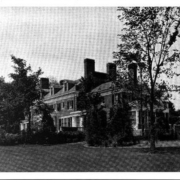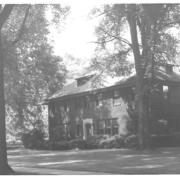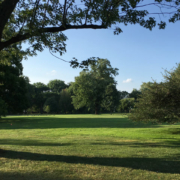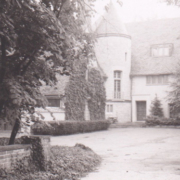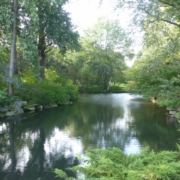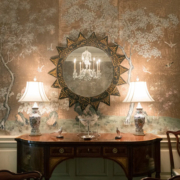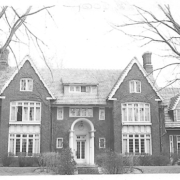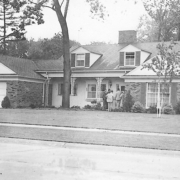Historical Architecture of Grosse Pointe – The Lost Estates – 415 Lakeshore
This week we continue with our review of the lost estates of Lakeshore. We have featured some wonderful homes, all of which have been lost overtime. Most recently we featured ‘Cherryhurst’ the home of Paul H. Deming located at 111 Lakeshore.
What makes the homes on Lakeshore so interesting, and also so difficult to research is how many of the house numbers have changed in Grosse Pointe Farms. The new numbers were issued in the late 1930’s. This is the case with many of the lost mansions we featured, including –
447 – 457 (Roy D. Chapin)
421 – 431 (William P. Stevens
273 – 259 (Frank P. Chesbrough)
429 – 437 (Richard H. Webber)
415– 421 (J. Brooks Nichols)
*red text denotes the house number we referenced.
We now turn our attention to 415 Lakeshore. Unlike so many of the ‘lost mansions’ (whose street numbers have also been lost over time), this number still exists, although the mansion that now occupies the plot is vastly different from the original home.
415 Lakeshore was built in 1914 for Lieutenant Colonel J. Brooks Nichols. The immense 20,000 sq ft home, was situated on a large 1,200 x 300 sq ft plot that stretched all the way back to Kercheval. The estate included beautiful gardens, a cottage, and stables. The classically styled colonial home featured a large center hall, drawing room, music room, library, a ballroom and servants quarters. Source: Grosse Pointe Historical Society. Very few images of this home exist, however we were able to find these images online. Source: http://www.beyondthegildedage.com/
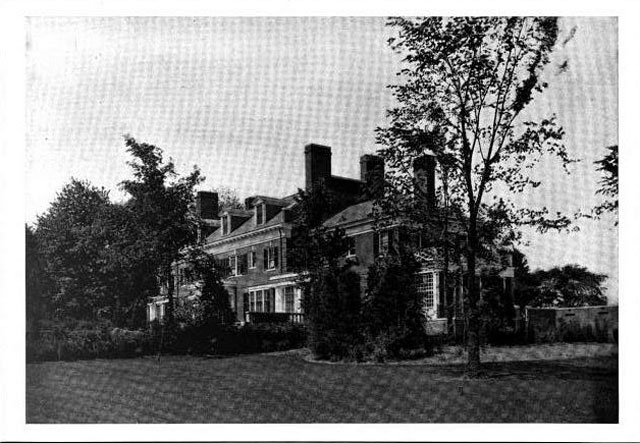


Renowned New York landscape architect William Pitkin, Jr. designed the garden. Pitkin had already completed several projects in Grosse Pointe, including the garden at the home of Truman H. Newberry (1914) along with the magnificent garden at the Mrs. Henry Stephens estate, located at 241 Lakeshore (1913) – you can read the full story of this home by clicking here.

415 Lakeshore was designed by the talented duo of Chittenden and Kotting. These two designers began working together in 1903. The partnership lasted 13 years, and during their time together they creating a number of ‘landmark’ buildings in Detroit including several Detroit firehouses, along with many prestigious residential projects in Indian Village and Grosse Pointe, including:
- 43 McKinley – built in 1905 (for Dr. Ernest T. Tappey)
- 35 McKinley – built in 1909 (for David Gray)
- 16900 East Jefferson – built in 1913 (for Frank W. Hubbard)
- 1014 Bishop – built in 1914 (for Harry C. Walker).
- 4 Rathbone Place – built in 1914 (for Samuel T. Douglas)
Both men had reputations as incredibly skilled designers. Alphus Chittenden is also credited with designing the Detroit Boat Club on Belle Isle, and the Detroit Stove Works plant, along with many prestigious residential projects in and around Metro Detroit. Charles Kotting created over 100 structures in Metro Detroit, and, after his split from Chittenden, several solo projects in Grosse Pointe (You can read the full story of Charles Kotting by clicking here.
The owner of 415 Lakeshore, J. Brooks Nichols, was born in New York in 1885. He attended Yale University, completing a scientific course in 1908. After graduating he worked in the oil business in Lexington, Kentucky. He then came to Detroit to take up the position of director at the United States Radiator Corporation. During his career J. Brooks Nichols had a vast array of business interests, and he became a highly respected figure in the city.
During World War I Mr. Nichols went to Officers’ Training Camp, won his commission and rose to the rank of Major. He would lead a successful command to northern Russia, and for his services in the field J. Brooks Nichols was awarded several prestigious honors. In 1920 he became an officer, director and large stockholder in the Franklin Baker Company (manufacturers and distributors of coconut products), and left Grosse Pointe to continue his career with Franklin Baker in Philadelphia.
Brooks Nichols sold his magnificent estate to Bart E. Taylor, a prominent Detroit real estate developer. In 1947 Henry Ford II purchased the home. It was then sold in 1957, and was subsequently demolished in the late 1950’s. Source: Grosse Pointe Historical Society.
Written by Katie Doelle
Copyright © 2018 Katie Doelle

